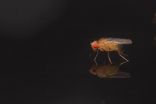(Press-News.org) "We're using less expensive raw materials in smaller amounts, we have fewer production steps, and have potentially lower total energy consumption," PhD candidate Fredrik Martinsen and Professor Ursula Gibson of the Department of Physics at NTNU explain.
They recently published their technique in Scientific Reports.
Their processing technique allows them to make solar cells from silicon that is 1000 times less pure, and thus less expensive, than the current industry standard.
Glass fibers with a silicon core
The researchers' solar cells are composed of silicon fibers coated in glass. A silicon core is inserted into a glass tube about 30 mm in diameter. This is then heated up so that the silicon melts and the glass softens. The tube is stretched out into a thin glass fiber filled with silicon. The process of heating and stretching makes the fiber up to 100 times thinner.
This is the widely accepted industrial method used to produce fiber optic cables.
But researchers at the Department of Physics at NTNU, working with collaborators at Clemson University in the USA, are the first to use silicon-core fibers made this way in solar cells.
The active part of these solar cells is the silicon core, which has a diameter of about 100 micrometres.
Lower energy consumption
This production method also enabled them to solve another problem: traditional solar cells require very pure silicon.
The process of manufacturing pure silicon wafers is laborious, energy intensive and expensive.
"We can use relatively dirty silicon, and the purification occurs naturally as part of the process of melting and re-solidifying in fiber form", says Gibson. "This means that you save energy, and several production steps."
This method is estimated to take roughly one-third of the energy needed to produce solar cells compared to the traditional approach of producing silicon wafers.
Gibson has worked for several years to combine purification and solar cell production. She got the idea for the project after reading an article on silicon core fibers by John Ballato at Clemson University in South Carolina, who is at the forefront of research in fiber optics materials development.
"I saw that the method he described could also be used for solar cells," she said, "and we developed a key technique at NTNU that improved the fiber quality."
Gibson and her research group began to work with Ballato, who is a co-author of the article published in Scientific Reports.
Silicon rods
The new type of solar cells are based on the vertical rod radial-junction design, which is a relatively new approach. The design uses less pure silicon that a planar cell, Martinsen explains, who then launches into a crash-course on the inner workings of a solar cell: photons of different wavelengths are absorbed in different layers of the silicon wafer.
They generate free charges, or charge carriers, which are then separated to provide electrical energy. These charges need to be close to the electrodes and close to the p-n junction to be captured. The p-n junction is the active region in the device where different
types of charge carriers are separated.
If the charge is not captured, the energy dissipates and goes to heating up the solar cell itself.
In a traditional solar cell, the journey from where a charge is generated to the surface can be quite long. This means that highly purified silicon is required.
But with silicon fibers, there is a junction all the way around the fiber. The distance from where the charge is generated to where it is captured is quite short. Charge carriers can be captured effectively, even when using impure silicon.
"The vertical rod design still isn't common in commercial use. Currently, silicon rods are produced using advanced and expensive nano-techniques that are difficult to scale," Martinsen says. "But we're using a tried and true industrial bulk processes, which can make production a lot cheaper."
Potential
The power produced by prototype cells is not yet up to commercial standards. Contemporary solar cells have an efficiency of about 18 per cent. The prototype created by NTNU researchers has only reached about 3.6 per cent.
Gibson and Martinsen still have faith in the potential of this production method, and are working to improve the design and fabrication processes.
"These are the first solar cells produced this way, using impure silicon. So it isn't surprising that the power output isn't very high," says Martinsen. "It's a little unfair to compare our method to conventional solar cells, which have had 40 years to fine-tune the entire production process. We've had a steep learning curve, but not all the steps of our process are fully developed yet. We're the first people to show that you can make solar cells this way. The results are published, and the process is set in motion."
The next step is to refine production, make larger and more effective solar cells, and couple multiple cells together.
INFORMATION:
Reference: Silicon-core glass fibres as microwire radial-junction solar cells. F. A. Martinsen, B. K. Smeltzer, M. Nord, T. Hawkins, J. Ballato & U. J. Gibson. Scientific Reports 4, Article number: 6283; doi:10.1038/srep06283
Bright colours appear on a fruit fly's transparent wings against a dark background as a result of light refraction. Researchers from Lund University in Sweden have now demonstrated that females choose a mate based on the males' hidden wing colours.
"Our experiment shows that this newly-discovered trait is important in female choice in fruit flies, and is the first evidence that wing interference patterns have a biological signalling function between the sexes during sexual selection", said Jessica Abbott, a biologist at Lund University.
The extremely thin wings of the ...
DURHAM, N.C. -- Doctors at Duke University Hospital have developed a new collaborative model in cancer care that reduced the rates at which patients were sent to intensive care or readmitted to the hospital after discharge.
The Duke researchers shared their findings today at the Palliative Care in Oncology Symposium sponsored by the American Society of Clinical Oncology.
In the new treatment model, medical oncologists and palliative care physicians partnered in a "co-rounding" format to deliver cancer care for patients admitted to Duke University Hospital's solid tumor ...
Predicting which people will commit murder is extremely difficult, according to a new study by criminologists at The University of Texas at Dallas.
Dr. Alex Piquero, Ashbel Smith Professor of criminology and co-author of the paper, said he and his fellow researchers were motivated by the lack of scientific literature on distinguishing people who will commit homicide from those who will not.
According to the study, the similarities outweigh the differences between the two groups.
"Based on a whole slew of characteristics that we know predict and differentiate criminal ...
ITHACA, N.Y. – For the first time, a team of interdisciplinary researchers have made recordings of neurons associated with visual perception inside the poppy seed-sized brain of a jumping spider (Phidippus audax).
Video: http://www.cornell.edu/video/vision-in-jumping-spiders/s252/e552
Though neurobiologists have tried for half a century to better understand the brains of jumping spiders, no one has succeeded. The liquid in spiders' bodies is pressurized, as they move with hydraulic pressure and muscles, so they don't tolerate previous research techniques.
As ...
Patients diagnosed with high blood pressure are given better control of their condition from a physician-pharmacist collaborative intervention than physician management alone, according to new research.
Pharmacists can play a key role in communicating with physicians to address suboptimal therapy, helping physicians to provide counselling on lifestyle change and performing patient follow-up.
The research was carried out to evaluate the individual care processes of the physician-pharmacist collaborative intervention in treating hypertension, a major cause of heart disease, ...
CHAPEL HILL, NC – UNC School of Medicine researchers have pinpointed a set of intriguing characteristics in a previously unknown subpopulation of melanoma cancer cells in blood vessels of tumors. These cells, which mimic non-cancerous endothelial cells that normally populate blood vessels in tumors, could provide researchers with another target for cancer therapies.
The research, published today in the journal Nature Communications, provides evidence for how these particular melanoma cells help tumors resist drugs designed to block blood vessel formation.
"For ...
Those who self-harm as teenagers are more at risk of developing mental health and substance misuse problems as adults, new research from the biggest study of its kind in the UK has revealed.
Researchers at the University of Bristol, working together with colleagues from the University of Oxford and University College London, collected data from 4,799 adolescents as part of Children of the 90s - one of the world's largest population studies - to examine the outcomes of self-harm for the first time.
The research paper, funded by the Medical Research Council and published ...
When a toddler takes their first steps we observe an uncertain sway in their walking. Being unsteady on our feet is something we can experience throughout life – and a new study has shown how even the lightest fingertip touch can help people to maintain their balance.
The research, led by the University of Birmingham, explains how neural and mechanical mechanisms synchronize our sway with another person.
Dr Raymond Reynolds explained, "There's something very human, very instinctive, that makes us reach out and grab something or someone when we're unsure of our ...
The search for blood-borne biomarkers that could be used to screen for colorectal cancer (CRC) has uncovered two promising candidates that may one day lead to the development of a simple blood test. Scientists have been piecing together the molecular events involved in the development of CRC and have identified abnormal DNA methylation patterns and the presence of microRNAs as major players in the carcinogenic process.
Speaking to journalists today at the 22nd United European Gastroenterology Week (UEG Week 2014) in Vienna, Austria, Dr Antoni Castells from the Institute ...
Rates of type 1 diabetes—the autoimmune form of the condition that often begins in childhood and eventually results in lifelong dependency on insulin—are increasing in almost all nations worldwide. However, while it appears possible from research in other forms of diabetes that physical exercise could slow the progression of this disease, there have been no studies to date that explore this in patients with type 1 diabetes. In a paper published in Diabetologia (the journal of the European Association for the Study of Diabetes) researchers argue that such trials ...



